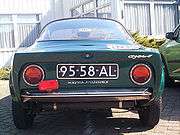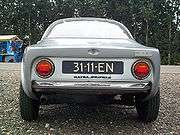Matra Djet
The Matra Djet is a French sports car that was originally designed and sold by René Bonnet. As the Bonnet Djet it was the world's first rear mid-engined production road car.[1] Different versions of the car were produced from 1962 until 1967 and sold under a variety of names that included René Bonnet Djet, Matra Bonnet Djet, Matra Sports Djet and finally, Matra Sports Jet.
| Matra Djet | |
|---|---|
 | |
| Overview | |
| Manufacturer | Automobiles René Bonnet, Matra Automobiles |
| Also called | René Bonnet Djet, Matra Bonnet Djet, Matra Sports Djet, Matra Sports Jet |
| Production | 1962–1964 (René Bonnet), 1965-1967 (Matra) |
| Assembly | France |
| Designer | René Bonnet, Jacques Hubert (original design) Philippe Guédon (redesign) |
| Body and chassis | |
| Class | Sports car |
| Body style | 2-door berlinette |
| Layout | MR layout |
| Related | Renault 8 (engine), Renault Estafette (gearbox) |
| Powertrain | |
| Engine | 1,108 cc Renault Cléon-Fonte OHV I4, 1,255 cc Renault Cléon-Fonte OHV I4 (tuned by Gordini) |
| Transmission | 4-speed manual |
| Dimensions | |
| Wheelbase | 2.40 metres (94.5 in) |
| Length | 4.22 metres (166.1 in) |
| Width | 1.50 metres (59.1 in) |
| Height | 1.20 metres (47.2 in) |
| Curb weight | 660 kg (1,455 lb) |
| Chronology | |
| Successor | Matra 530 |
The Djet
The car started out as the René Bonnet Djet in June 1962. This model became known in retrospect as the Djet I. The car was named "Djet" because Bonnet thought the French would not pronounce the word "jet" correctly. It was powered by a 65 PS (64 hp) 1,108 cc engine from a Renault 8 in a mid-engine location mated to a gearbox from the Renault Estafette van.[2] This power-train gave the car a top speed of 165 km/h (103 mph), or 190 km/h (118 mph) in the later Djet III with a Gordini engine. The fiberglass body was made by Matra, and was bonded directly to a steel chassis. The Djets were built in a factory in Romorantin owned by Matra. The competition Aérodjet of 1963 (pictured in the gallery) came with special long-tailed bodywork and bigger fenders to accommodate wider wheels.
The Djet's suspension was quite advanced for the time, being a fully independent system having upper and lower A-arms with coil springs and disc brakes at all four wheels. The car accommodated just two people, as the engine took the space where a rear seat would otherwise be. The Djet I was 3,800 mm (149.6 in) long by 1,400 mm (55.1 in) wide by 1,150 mm (45.3 in) high and weighed only 600 kg (1,323 lb). Announced in 1962, the Bonnet Djet was the world's first mid-engined production road car, beating the De Tomaso Vallelunga which was introduced in 1963, even though the first production Djets did not leave the factory until July 1963.[3] During the two years before Matra took over, 198 Bonnet Djets were produced, with all but 19 being built to the lower-powered Djet I specification. After becoming the Matra Djet in 1964 a further 1,491 cars were produced before production ended in 1968.[3] Fewer than 60 Vallelungas were built before De Tomaso replaced it with the Mangusta in 1967.
The Djet was priced at 20,000 French francs at launch, the same as its much larger and more luxurious contemporary, the Facel-Vega Facellia.[3] Bonnet believed that the competition record of the Djet and his company would be enough to convince the public to purchase the Djet, but this would not prove to be the case.
Matra takes control
When Bonnet got into financial troubles, Matra, who already supplied both the bodyshells and the factory for the Djet, took over René Bonnet Automobiles and its debts in October 1964.[2][4] Production of the original Djet was stopped in December 1964. Matra's CEO Jean-Luc Lagardère considered this a great opportunity for Matra to expand into the automobile market. Former Simca designer Philippe Guédon was hired to modify the original Bonnet Djet. The car became slightly bigger, measuring 4,220 mm (166.1 in) long by 1,500 mm (59.1 in) wide by 1,200 mm (47.2 in) high and weighing 660 kg (1,455 lb). Production resumed in April 1965 with two new versions; the Matra Bonnet Djet V and the Djet V S, the latter having a Gordini-tuned engine.
During his 1965 tour of France, Yuri Gagarin was presented with a Matra Bonnet Djet V S coupé by the French government.[2] The car was later photographed wearing Soviet license plates.[5]
After the Paris Motor Show in 1965, the Roman numerals and the Bonnet name were dropped. The car was now called the Matra Sports Djet 5. In 1966, a version with a bigger Gordini engine became available and the Djet name was dropped in favour of its original meaning: Jet. The model range now consisted of the Jet 5 (1,108 cc Renault 8 Major engine), Jet 5 S (1,108 cc Renault 8 Gordini engine) and Jet 6 (1,255 cc Renault Gordini engine).
Model range
René Bonnet Djet
There were four types of René Bonnet Djet:
- René Bonnet Djet I
- 1,108 cc Renault 8 Major engine (65 PS), 165 km/h (103 mph)
- René Bonnet Djet II
- 1,108 cc Renault 8 Gordini engine (80 PS), 190 km/h (118 mph)
- René Bonnet Djet III / Djet IV
- 996 cc engine with double overhead camshafts (80 or 100 PS). These models were developed for competition use.[3]
Only 198 René Bonnet Djets were built between 1962 and 1964, 179 of which were of the lesser Djet I model.
Matra Bonnet Djet / Matra Sports Djet / Matra Sports Jet
Three types of Matra Bonnet/Matra Sports Djet/Jet were produced from 1965 until 1967:
- Matra Bonnet Djet V / Matra Sports Djet 5 / Jet 5
- 1,108 cc Renault 8 Major engine, 70 bhp (52 kW), 170 km/h (106 mph)
- Matra Bonnet Djet V S / Matra Sports Djet 5 S / Jet 5 S
- 1,108 cc Renault 8 Gordini engine, 90 bhp (67 kW), 190 km/h (118 mph)
- Matra Sports Jet 6
- 1,255 cc Renault 8 Gordini engine, 105 bhp (78 kW), 210 km/h (130 mph).
Apart from these model designations, a luxury version with wooden dashboard and bigger bumper was available.
Production of the Jet ended in 1967 with a total of 1,495 Matra (D)Jets and it was replaced with the Matra 530. The last Jets (all Jet 6s) were sold in 1968.
Specifications
| Matra Djet | ||||||||||||||
| Model | Engine | Displacement | Maximum horsepower | Maximum torque | Dry weight | Top speed | Years produced | Price at introduction | Number produced | |||||
| Djet I (C.B.R 1) | C1E | 1,108 cc (67.6 cu in) | 52.2 kW (70 hp) @ 6,000 | 84 N⋅m (62.0 lb⋅ft) @ 4,800 | 610 kg (1,344.8 lb) | 170 km/h (105.6 mph) | 1962-1964 | 18,000 FF | 159 | |||||
| Djet I (C.B.R 2) | 59.7 kW (80 hp) @ 6,500 | 175 km/h (108.7 mph) | 1962-1964 | 25,000 FF | ||||||||||
| Djet II | Renault | 996 cc (60.8 cu in) | 63.4 kW (85 hp) @ 6,500 | 180 km/h (111.8 mph) | 1963-64 | 21,000 FF | 34 | |||||||
| Djet III2 | 996 cc (60.8 cu in) 1,108 cc (67.6 cu in) | 59.7 kW (80 hp) @ 6,500 rpm 74.6 kW (100 hp) @ 6,500 rpm | - | 175 km/h (108.7 mph) 200 km/h (124.3 mph) | 1963-64 | 25,000 FF | 161 | |||||||
| Djet IV2 | 30,000 FF | |||||||||||||
| Aerodjet2 | Renault | 996 cc (60.8 cu in) 1,108 cc (67.6 cu in) | 48.5 kW (65 hp) @ 6,000 | - | - | 155 km/h (96.3 mph) | 1963 | 20,000 FF | 5 | |||||
| Djet V3 | C1E | 1,108 cc (67.6 cu in) | 52.2 kW (70 hp) @ 6,000 | 84 N⋅m (62.0 lb⋅ft) @ 4,800 | 615 kg (1,355.8 lb) | 175 km/h (108.7 mph) | 1964-1968 | 19,800 FF | 916 | |||||
| Djet V S3 | 70.1 kW (94 hp) @ 6,500 | 98 N⋅m (72.3 lb⋅ft) @ 4,000 | 660 kg (1,455.1 lb) | 187 km/h (116.2 mph) 200 km/h (124.3 mph) | 1964-1967 | 23,000 FF | 355 | |||||||
| Jet 6 | Type 812 | 1,255 cc (76.6 cu in) | 78.3 kW (105 hp) @ 6,800 | 98 N⋅m (72.3 lb⋅ft) @ 4,000 | 740 kg (1,631.4 lb) | 200 km/h (124.3 mph) | 1966-1968 | 23,800 FF | 222 | |||||
| Note: 1Calculated number based on difference between sources which include the Djet III and Djet IV in total units produced until 1964 and others which exclude these models.[6][7] 2Competition models 3In 1965 the name changed from Djet V to Djet 5, and in 1966 it changed again, dropping the D to become the Jet 5. This also applied to the Djet VS | ||||||||||||||
Gallery
 René Bonnet Aérodjet, as used for a DNF at Le Mans 1964
René Bonnet Aérodjet, as used for a DNF at Le Mans 1964 Matra Bonnet Djet dashboard
Matra Bonnet Djet dashboard Matra Bonnet Djet V rear
Matra Bonnet Djet V rear Matra Sports Jet 6 front
Matra Sports Jet 6 front Matra Sports Jet 6 rear
Matra Sports Jet 6 rear
References
- Silvestro, Brian (2019-09-16). "You Can Drive the Same Car As the First Man in Space". Road & Track. Retrieved 2020-04-05.
- McCourt, Mark J. (June 2019). "Fiberglass Flyer - 1965 Matra Bonnet D'Jet V". www.hemmings.com. Retrieved 2020-04-05.
- Dupuis, Sébastien (2010-03-26). "L'Auto-didacte: Guide de l'achat, Matra Djet (1962-1968)". L'Automobile Sportive.
- "Matra D'Jet5- 1965". Lane Motor Museum. Retrieved 2020-04-05.
- "Djet Yuri Gagarin". Matrasport DK. 2006-03-21.
- Table data from www.matrasport.dk: see right-hand list of chassis numbers
- Matra Djet - "Auto Collection" No. 42, page 14, (edited by the Société de presse automobile et de loisirs, SPAL)
External links
| Wikimedia Commons has media related to Matra (D)Jet. |
- Matra D'Jet
- Matra Enthusiasts Club UK
- Simca en Matra Sports club (Dutch)
- Club René Bonnet Matra Sports (French)